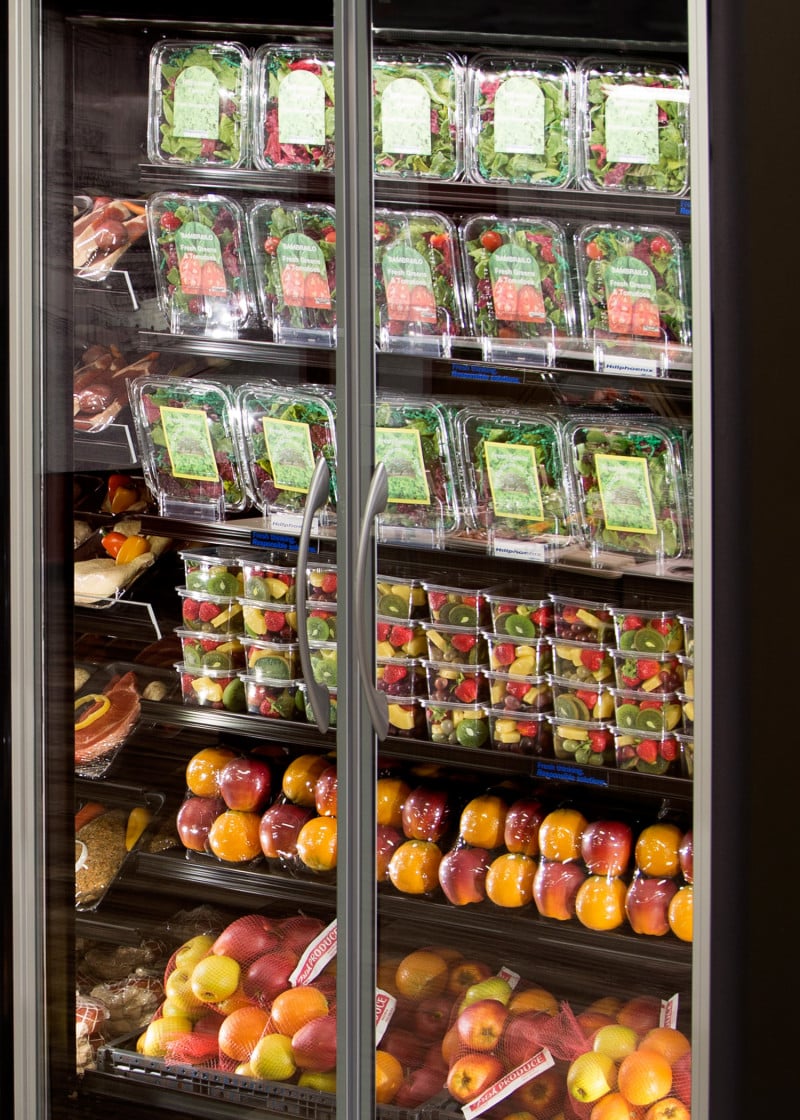Small-Format Strategies: Merchandising tips that make every square foot count

By Margie Proctor
Hillphoenix Marketing & Design Specialist
In small-format stores, every square foot counts. That’s why it’s important for convenience, discount and drug stores to save space, while also maximizing merchandising opportunities. So, what can small-format stores do to make the most of their space and ensure that small feels special to shoppers? Here are a few strategies:
Elevate endcaps
Don’t stuff end caps with past-their-prime discounts or the staples shoppers already know you sell. Instead, use that prime real estate to showcase goods that will surprise and delight your customers. For example, encourage shoppers to bring home a “picnic for dinner” with a basket displaying wine, fruit, crackers and a tasting of fresh cubed cheeses and deli meats available in nearby refrigerated display cases. Borrow from the gourmet stores and use an artistically rendered chalkboard to explain the concept — and prices — to shoppers.
If the idea catches on, display a few pre-packed picnic bags in your refrigerated section, so all shoppers have to do is grab and go. Keep it simple, inexpensive and secure by using brown, handled shopping bags (adorned with a sticker or stamp featuring your store’s logo and a “Picnic to Go” label) protectively wrapped in clear cellophane. Tie up the cellophane with ribbon or twine, and attach a colorful tag indicating what’s inside. Voila! Your everyday items just morphed into a convenient home meal imbued with a sense of adventure and even a little romance.
Update your temptations
If display shelves near your checkout counter are filled only with candy bars and plastic-wrapped pastries, it’s time for a change. A report by Nielsen shows North Americans now choose fruit and vegetable snacks over sweets like cookies and cakes. Install a low-profile refrigerated case at your checkout counter and stock it with freshly cut produce and healthy teas or waters. Not only will you encourage impulse buying that aligns with what shoppers want, you’ll also capitalize on the higher costs they’re willing to pay for healthy snacks.
Want to keep serving those shoppers who always buy confectionary at the checkout? Reserve a little upfront display space for your best-selling candy bars and draw attention to them with a “Guilty Pleasures” sign. It’s fun, engaging and indulgent.
Take a critical look at crucial equipment
Do your commercial refrigerators help you accomplish more than one operational goal? Look for equipment that can save space, keep your foods fresh longer and help you hit your financial targets. The multi-tasking prowess of AdvansorFlex, the new CO2-based refrigeration system that’s part of Hillphoenix’s Second Nature line, has captured the attention of small-format store owners. AdvansorFlex is about 20% smaller than standard commercial refrigeration systems and full-size CO2 options, so it makes great use of limited space. It’s also less expensive than full-size CO2 systems, and it competes with traditional refrigeration systems on price, if retailers consider total cost of ownership.
Alternative CO2 refrigerant is at least six times cheaper than traditional refrigerant. Energy, installation and maintenance costs are lower, too. And switching to CO2 helps food retailers lessen the burden of environmental regulation. Plus, the technology in CO2 case controllers regulates temperature better than traditional refrigeration systems. Food stays fresher and salable longer — reducing shrink and increasing opportunities for higher-dollar fresh food sales.
Evolve your offerings
This connects back to the “temptations” item above. In small spaces, you need to make sure every inch is dedicated to products that your customers want to buy now. But you have the unique advantage of having a bird’s-eye view of customers’ evolving tastes from behind the cash register. Your employees know your regular customers and have a good sense of what’s selling and what’s falling out of favor. Ask your employees for their insights. Ask your customers, too. Walk the aisles and talk to people about what they like, and what they’d like to see more of. Pay attention to whether any products are collecting dust. Use merchandising to help customers discover new products or to encourage them to think about existing offerings differently. (Picnic, anyone?) Keep a regular watch on what’s working — and what’s not. In a small store, you can’t afford to give precious space to slow-moving goods.
Small stores offer unique opportunities for engaging customers and selling more food. If you employ the right operational and merchandising strategies, your customers will see that small is special.